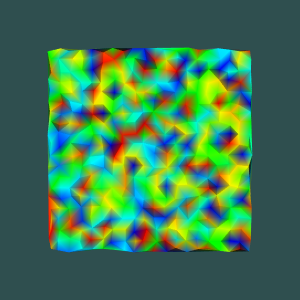ColoredElevationMap
vtk-examples/Python/Meshes/ColoredElevationMap
Description¶
This example creates a elevation map with different color based on height.
Question
If you have a question about this example, please use the VTK Discourse Forum
Code¶
ColoredElevationMap.py
#!/usr/bin/env python
# noinspection PyUnresolvedReferences
import vtkmodules.vtkInteractionStyle
# noinspection PyUnresolvedReferences
import vtkmodules.vtkRenderingOpenGL2
from vtkmodules.vtkCommonColor import vtkNamedColors
from vtkmodules.vtkCommonCore import (
vtkLookupTable,
vtkMinimalStandardRandomSequence,
vtkPoints,
vtkUnsignedCharArray
)
from vtkmodules.vtkCommonDataModel import vtkPolyData
from vtkmodules.vtkFiltersCore import vtkDelaunay2D
from vtkmodules.vtkRenderingCore import (
vtkActor,
vtkPolyDataMapper,
vtkRenderWindow,
vtkRenderWindowInteractor,
vtkRenderer
)
def main():
named_colors = vtkNamedColors()
# Create a grid points
points = vtkPoints()
GridSize = 20;
xx = 0.0
yy = 0.0
zz = 0.0
rng = vtkMinimalStandardRandomSequence()
rng.SetSeed(8775586) # For testing.
for x in range(0, GridSize):
for y in range(0, GridSize):
rng.Next()
xx = x + rng.GetRangeValue(-0.2, 0.2)
rng.Next()
yy = y + rng.GetRangeValue(-0.2, 0.2)
rng.Next()
zz = rng.GetRangeValue(-0.5, 0.5)
points.InsertNextPoint(xx, yy, zz)
# Add the grid points to a polydata object
inputPolyData = vtkPolyData()
inputPolyData.SetPoints(points)
# Triangulate the grid points
delaunay = vtkDelaunay2D()
delaunay.SetInputData(inputPolyData)
delaunay.Update()
outputPolyData = delaunay.GetOutput()
bounds = 6 * [0.0]
outputPolyData.GetBounds(bounds)
# Find min and max z
minz = bounds[4]
maxz = bounds[5]
print('minz: {:< 6.3}'.format(minz))
print('maxz: {:< 6.3}'.format(maxz))
# Create the color map
colorLookupTable = vtkLookupTable()
colorLookupTable.SetTableRange(minz, maxz)
colorLookupTable.Build()
# Generate the colors for each point based on the color map
colors = vtkUnsignedCharArray()
colors.SetNumberOfComponents(3)
colors.SetName('Colors')
print('There are ' + str(outputPolyData.GetNumberOfPoints()) + ' points.')
for i in range(0, outputPolyData.GetNumberOfPoints()):
p = 3 * [0.0]
outputPolyData.GetPoint(i, p)
dcolor = 3 * [0.0]
colorLookupTable.GetColor(p[2], dcolor);
# print( 'dcolor: {:<8.6} {:<8.6} {:<8.6}'.format(*dcolor))
color = 3 * [0.0]
for j in range(0, 3):
color[j] = int(255.0 * dcolor[j])
# print('color: {:<8} {:<8} {:<8}'.format(*color))
try:
colors.InsertNextTupleValue(color)
except AttributeError:
# For compatibility with new VTK generic data arrays.
colors.InsertNextTypedTuple(color)
outputPolyData.GetPointData().SetScalars(colors)
# Create a mapper and actor
mapper = vtkPolyDataMapper()
mapper.SetInputData(outputPolyData)
actor = vtkActor()
actor.SetMapper(mapper)
# Create a renderer, render window, and interactor
renderer = vtkRenderer()
renderWindow = vtkRenderWindow()
renderWindow.AddRenderer(renderer)
renderWindow.SetWindowName('ColoredElevationMap')
renderWindowInteractor = vtkRenderWindowInteractor()
renderWindowInteractor.SetRenderWindow(renderWindow)
# Add the actor to the scene
renderer.AddActor(actor)
renderer.SetBackground(named_colors.GetColor3d('DarkSlateGray'))
# Render and interact
renderWindow.Render()
renderWindowInteractor.Start()
if __name__ == '__main__':
main()
